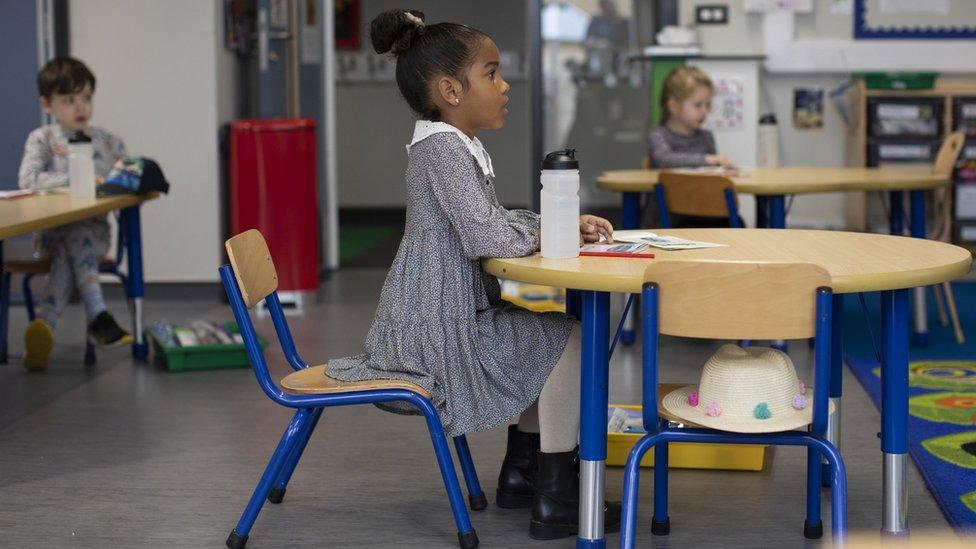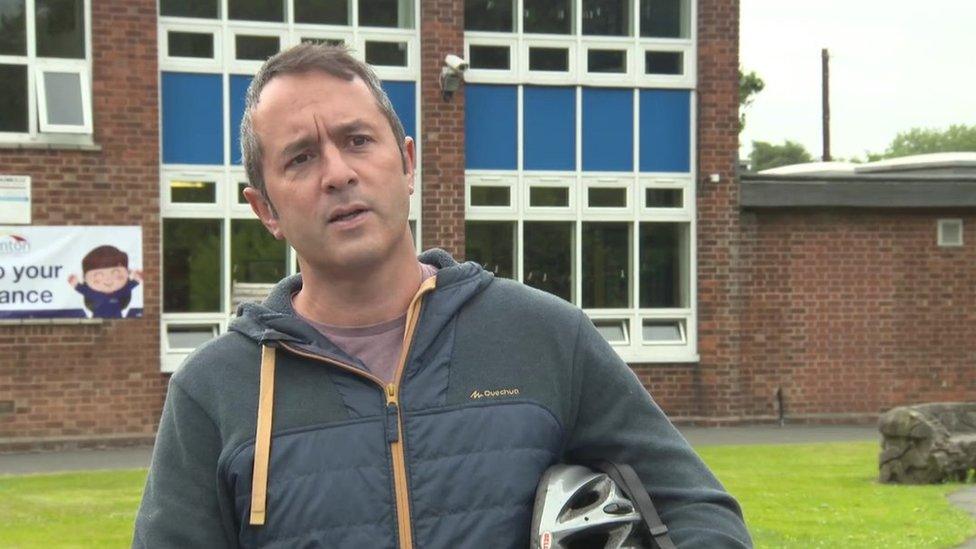Coronavirus: Plan dropped for all primary pupils back in school
- Published
- comments

The plan for all primary school years in England to go back to school before the end of term is to be dropped by the government.
There had been an aim for all primary pupils to spend four weeks in school before the summer break.
But it is no longer thought to be feasible and instead schools will be given "flexibility" over whether or not to admit more pupils.
Head teachers' leaders said it had never been a practical possibility.
It comes after Health Secretary Matt Hancock conceded at Monday's Downing Street briefing that secondary schools in England may not fully reopen until September "at the earliest".

How many pupils are going back to school?
Primary pupils in England in Reception, Year 1 and 6 began to return to school last week - and figures published by the Department for England have shown how many attended, based on 4 June.
It shows that about three quarters of those who could have returned to school were still at home - reflecting that almost half of schools were not open for extra pupils.
52% of primary schools opened for extra pupils
11% of primary pupils were in school - about a quarter of those year groups who could have gone back
659,000 children were in all schools, including children of key workers, almost 7% who would normally attend, up from 2.6% before half term

Prime Minister Boris Johnson will chair a cabinet meeting later to discuss the next steps to ease lockdown restrictions, before Education Secretary Gavin Williamson delivers a statement to the House of Commons on the reopening of schools.
There are separate rules for managing the threat of coronavirus in England, Wales, Scotland and Northern Ireland.
Children in England began returning to primary schools in a phased process last week, with Reception, Year 1 and Year 6 pupils heading back first.
Mr Williamson will give an indication later of how many more pupils in England have returned, but he is also expected to say that primary schools will no longer have to prepare for the return of all pupils, as previously proposed by the government.
The "pressure" to get ready will be removed, with heads and governors being free to decide whether they can bring in more classes.

Analysis
By Hannah Richardson, BBC Education reporter
Today's announcement is expected to make formal what head teachers and governors in England have been saying for some time.
It's not possible to massively increase the space each class needs to meet social distancing rules, and bring everyone back.
There's not enough room.
While Number 10 and the education secretary pushed on with the plans, they lost the support of some groups of parents, people working in schools and teaching unions.
There are the concerns that having more pupils in schools will contribute to an increase in Covid-19 infections, both among pupils and staff and in their communities, and the inconclusiveness of the scientific evidence on this.
Balanced against this are also the very real fears of parents, about how on earth they are going to manage with their youngsters at home for another two or three months - minimum - let alone keep up to date with their educational needs.
There are growing voices for the government to start to think more strategically and more creatively. A strategic national plan is being called for, one that realises the scale of the problem and matches the scale of the support the economy has seen.

The announcement means that many children in these other year groups will not be back in school until September or even after.
Care minister Helen Whately told BBC Breakfast that ministers "don't want to take risks that might increase the infection rates", but recognise that being out of school is "particularly a problem" for children from disadvantaged backgrounds and that the education gap "can widen".
Children's commissioner for England Anne Longfield told the programme that the prospect of secondary school pupils not returning until beyond September was "deeply worrying".
"It's a disruption we've not seen since the Second World War," she said.
She added that "the education divide is broadening" and "almost a decade of catching up on that education gap may well be lost".
Some students returned to school at the beginning of the month
She also called children's education to be made the number one priority in government, adding that otherwise there was a risk that "childhood is just going to be furloughed for months."
Commons Education Committee chairman Robert Halfon called for a national strategic plan to get schools open as soon as possible. He also warned that with schools remaining closed the majority of pupils would lose 40% of their time in class this year.
He told BBC Radio 4's Today programme: "I think we're a strange country in which we turn a blind eye to mass demonstrations all over in every city, we campaign for pubs and cafes to open and yet we say to open schools before September is too risky when all the evidence... suggests otherwise."
Mr Halfon also responded to concerns raised by a teacher on BBC Radio 5 live about schools having to fund supply teachers from their own budgets. "If schools need extra funding in order to make sure their classrooms are social distancing, than government should provide that funding," he said.

Parents' views are mixed
One mother told the Today programme that she was "unsurprised" but "incredibly disappointed" by the news.
"I feel really sad for my son. I've got one son in year two and another one in reception.
"My child in reception [has] gone back, albeit only four days a week, every other week.
"And my older son, who is just about to turn seven, is desperate to go back, can't understand, thinks it's so unfair - which it is."
But another mother, with two children aged eight and six, disagreed.
"I'm actually relieved if schools don't go back until September because I think it's too soon.
"They don't socially distance at that age. I don't think there's enough protective equipment available in school."

Head teachers had warned several weeks ago that it was not a realistic possibility to accommodate all primary year groups at the same time, with social distancing limiting their capacity.
Class sizes are now only 15 pupils or less - so if each class occupied two classrooms, school leaders argued that they would have no space for all year groups to return.
"The 'ambition' to bring back all primary year groups for a month before the end of the summer term was a case of the government over-promising something that wasn't deliverable," said Geoff Barton, leader of the ASCL head teachers' union.
"It isn't possible to do that while maintaining small class sizes and social bubbles," he said.
Paul Whiteman, of the National Association of Head Teachers, said "we're pleased to see the government will not force the impossible" and that the plan had too many "practical barriers".
Ian Robinson, chief executive of the Oak Partnership Trust, which runs primary schools and a special school in Somerset, told BBC Radio 4's Today programme the announcement shows ministers "are listening to the profession".

I MAY DESTROY YOU: The next must-see show in lockdown
TRAIN WRIGHT: Mark Wright's lockdown workout

Schools have remained open throughout the lockdown for children of key workers and vulnerable children.
But last Monday primary schools began the process of inviting back another two million children across three year groups.
Secondary pupils in Years 10 and 12 are to begin returning for some sessions in school from 15 June.
It is thought that primary pupil numbers have been increasing as parents have become more confident - but there have also been local concerns about different regional rates of infection.
Teachers' unions have warned that it is too early to return to school - and some local authorities have delayed a return in their areas.
But the Department for Education has argued that children need to get back to lessons - and that safety has been "paramount" in the plans to bring back more pupils.
Schools in Wales will reopen from 29 June to all age groups for limited periods during the week, while Scottish schools are to reopen at the start of the autumn term on 11 August, with some continued home-learning.
Some Northern Irish pupils preparing for exams and those about to move to post-primary schools will go back in late August, with a phased return for the rest in September.

A SIMPLE GUIDE: How do I protect myself?
IMPACT: What the virus does to the body
RECOVERY: How long does it take?
LOCKDOWN: How can we lift restrictions?
ENDGAME: How do we get out of this mess?

The UK has recorded its lowest daily rise in the number of coronavirus deaths since before lockdown on 23 March, according to the latest government figures.
A further 55 people died after testing positive with the virus as of 17:00 BST on Sunday, taking the total to 40,597.
There tends to be fewer deaths reported on Mondays - due to a reporting lag over the weekend.
The figures came as a study estimated lockdowns have saved more than three million lives from coronavirus in Europe.
Researchers from Imperial College London used computer models to predict the spread of the virus if no restrictions had been put in place in 11 European countries, finding that the "death toll would have been huge" without lockdown.
In the UK, the lockdown prevented 470,000 deaths up to 4 May, according to the study.
According to the Office for National Statistics (ONS), less than a fifth of deaths registered in England and Wales during the last week of May involved Covid-19 - the lowest proportion since the lockdown began.
There were 9,824 deaths registered during that week - less than the previous week, but still 1,653 deaths higher than what would usually be expected, the ONS said. Of these, 1,822 involved the virus.
- Published9 June 2020

- Published21 May 2020
- Published31 May 2020
